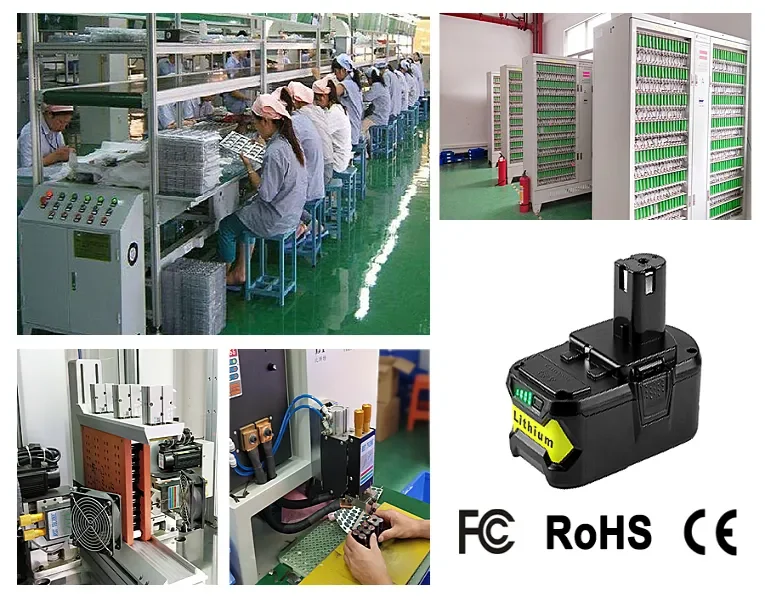How Do You Choose the Right Ryobi One+ 18V Replacement Battery? (XNJTG)
Confirm compatibility → capacity → safety. Match the pack to your tools and workload, prefer proven cells and a proper BMS, run a quick QA at purchase, and use cost-per-cycle to compare value — not just sticker price.

Quick buying principle (3 checks, 10–60 seconds)
-
Compatibility: physical latch, terminals and charger handshake must match Ryobi One+ 18V. A pack that fits but fails handshake = downtime.
-
Capacity: choose Ah to meet runtime goals (higher Ah = more runtime but also more weight).
-
Safety & provenance: prefer Grade-A cells + known BMS + certifications (UL / IEC / UN38.3). If the vendor can’t give cell model / batch info, walk away.
Capacity quick guide — match Ah to real work
| Use case | Recommended Ah | Why |
|---|---|---|
| Light, occasional tasks | 1.5–2 Ah | Lowest weight, best balance for short jobs |
| Everyday homeowner | 3–4 Ah | Good runtime without excessive bulk |
| Pro / heavy continuous use | 5 Ah+ or multiple packs | Fewer swaps, longer continuous runtime |
Rule of thumb: pick the lowest weight that meets your runtime target — that minimizes fatigue while delivering enough runtime.
Cell quality & BMS: what to ask sellers right now
-
Cell brand/model: Samsung, Panasonic, LG, Sanyo — ask for exact model numbers.
-
Grade: insist on Grade-A cells; avoid “mystery” or anonymous cells.
-
BMS features: over-charge, over-discharge, over-current/short, thermal cutoff, and cell balancing.
-
Traceability: batch/lot number and date code.
-
Certs: UL / IEC / UN38.3 (shipping), plus retailer return policy and warranty.
Industry insight: Ah is a headline — but two different packs with the same Ah can behave very differently in real use depending on cell chemistry, discharge curve, and BMS strategy. Cell provenance beats a slightly higher Ah from an unknown source.
Quick QA to run in the store or first hour after delivery
-
Seat & wiggle test: insert battery, wiggle gently — no intermittent fit or rattles.
-
Handshake test: put it on your charger, watch LED handshake; abnormal codes → return.
-
First charge: full initial charge and watch surface temp — should stay < ~45–50 °C.
-
Real-task runtime: run a representative tool for a timed interval and note runtime.
-
Sag spot check: under a moderate load, voltage sag shouldn’t be extreme — see troubleshooting guide for exact sag thresholds.
Return / defect signals (return immediately if any of these)
-
Unstable or intermittent contacts when seated.
-
Handshake codes or charger refusal to charge.
-
Rapid heating (>50 °C) on first charge or first use.
-
Strange smells, melting, or visible construction flaws.
Cost-per-cycle: compare true value (simple formula + example)
Formula:Cost-per-cycle-per-Ah = Cost ÷ (Rated cycles × Ah)
Example: $80 pack, rated 500 cycles, 3 Ah.
Step 1: cycles × Ah = 500 × 3 = 1500.
Step 2: Cost ÷ (cycles × Ah) = 80 ÷ 1500 = 0.053333... → $0.053 per Ah-cycle.
Use this to decide if a cheaper pack that dies early is actually more expensive over time.
Practical buying checklist (printable — PASS / FAIL)
1) Compatibility (PASS / FAIL)
-
Form factor = Ryobi One+ 18V (latch & terminals fit)
-
Charger family compatible (handshake tested or model confirmed)
-
Tool compatibility listed on vendor page
2) Capacity & ergonomics
-
Intended use matches Ah: 1.5–2 / 3–4 / 5+ Ah selected
-
Weight acceptable for your typical tasks
3) Cell quality & provenance
-
Cell brand/model listed: __________________
-
Grade-A / vendor traceability confirmed
-
Batch/lot or serial present
4) BMS & safety features
-
Over-charge protection
-
Over-discharge protection
-
Over-current / short protection
-
Thermal sensor / temp cutout
-
Cell balancing present
-
Certifications: [ ] UL [ ] IEC [ ] UN38.3
5) Build quality & durability
-
Solid housing / reinforced latch
-
Contacts are firm, no wobble
-
IP / dust‐splash rating noted (if jobsite exposure)
6) Charger behaviour & first QA
-
Fast-charge supported? (Y/N) __________________
-
Handshake tested on your charger (LED normal?) Y / N
-
First full charge: LED sequence normal? Y / N
-
Timed runtime on a real task: _______ minutes
-
Temperature during use: _______ °C (OK if <45–50 °C)
7) Warranty & ROI
-
Warranty: ______ months/years
-
Rated cycles (vendor) _______
-
Cost-per-cycle-per-Ah computed: $________
Pass rule: Any FAIL in safety or compatibility → do not buy / return immediately.
Quick persona cheat-sheet (one-line buys)
-
DIY / Occasional user: 2–3 Ah certified pack — light & cheap.
-
Weekend homeowner: 3–4 Ah, branded cells.
-
Pro / daily user: 5 Ah+ or multiple packs; prioritize warranty & traceability.
-
Mixed workflow (contractor + precise work): keep a lightweight 2 Ah for precision and a 5 Ah for heavy tasks.
Post-purchase care (keep your new pack healthy)
-
Charge in 5–25 °C ambient where possible.
-
Store at ~30–50% charge if not used for long periods.
-
Rotate packs (FIFO) to keep aging uniform.
-
Clean contacts monthly.
-
Use genuine chargers to ensure correct BMS communication.
Final buying tips & red flags
-
Red flag: seller can’t name the cell model or provide batch info.
-
Red flag: no certifications (UN38.3 for shipping at minimum).
-
Good sign: seller offers clear warranty, documented QA steps, and a simple return policy for RMA.
-
Value hack: pay slightly more for a certified pack with proven cell brand — you’ll usually win on cost-per-cycle and safety.